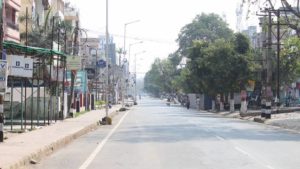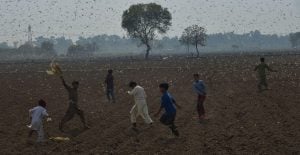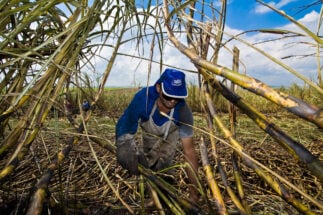Narrow alleyways hardly one metre wide are what pass as pathways in the 34 Rohingya camps in Cox’s Bazar, south-eastern Bangladesh, with no space for physical distancing possible. On top of that, a family of five to eight lives in each shack of ten square metres. This lack of space has now become a crippling concern as the Covid-19 pandemic has reached the refugee camps.
On May 14 Cox’s Bazar Medical College tested samples and one Rohingya man was identified as Covid-19 positive. Abu Toha M R H Bhuiya, Health Coordinator with the Refugee Relief & Repatriation Commissioner (RRRC) said that so far there are six people who have tested positive from the camps, including two women and a child. All of them are from Lambashiya, Kutupalong camp. Among them, one is from block F, Kutupalong East camp.
“2,400 families with more than 10,000 family members from Lambashiya’s 1-F, 2-W, 2-D camp are now in lockdown. Twelve isolation centres are in [the process of being set up]. Till the end of June 2020, there will be isolation centres with 19,000 beds dedicated to the Rohingya community. For now, we have facilitated 10 ICU and 10 CCU beds for Rohingya community in Cox’s Bazar Sadar Hospital. Moreover, two ambulances are on standby for the people in the camp in case of any emergency.”
According to Bhuiya, there are three ways that the transmission could have happened. Every night trucks from Dhaka, Chattogram and Narayanganj unload goods in the camps. All three cities are badly affected by the virus. A few Rohingya unload goods from those trucks. At night many Rohingya men go to Ukhiya and Teknaf Bazar for goods. At least 191 people in the district are affected by Covid-19. Lastly, three people working with aid agencies have been found Covid-19 positive. They used to visit the camps regularly.

“Covid-19 positive Rohingya individuals are now in isolation centres and we already have two dedicated hospitals each of 50 beds in Cox’s Bazar. Kutupalong camp is already locked down. We hope to control this situation with immense care,” said Mahbubur Rahman, a civil surgeon based at Cox’s Bazar.
Lack of communication
Aid groups are largely prohibited from entering the camps unless their work is about controlling the Covid-19 spread. WHO, UNHCR, IOM, and many other international and national organisations are working relentlessly. But many residents are still unaware of what they need to do to m9inimise the chances of infection. Many are still trying to go out of the camp.
“It is a challenge to control the Rohingya. Now and then they try to escape from camps and make several attempts. Now that it is summer and roads are dry, they take roads through jungles and remote villages to go out of the camp. And it is difficult to identify them because they are indistinguishable from local people and the language is same too. Yet we are trying our best to control them. Seven check posts have been established to control their movement from the camp,” said Cox’s Bazar Police Superintendent ABM Masud Hossain.
“The first Rohingya man who was Covid-19 positive escaped from a mosque,” Hossain added. More education and communication materials are needed to spread consciousness among Rohingya. Moreover, mass awareness on hygiene, identification of symptoms, prevention is required.
Isolation and hygiene
The camps have a 40,000-70,000 persons per square kilometre, almost four times the population density of New York City. Maintaining personal hygiene is a major challenge since space for sanitation is very limited. Many people have to use the same toilet. Moreover, summer has brought a water shortage crisis.

Communication is key to ensuring awareness. But in September 2019 the Bangladesh Telecommunication Regulatory Commission directed that internet speeds of 3G and 4G should be barred inside the camps for security reasons. While there have been security issues, and protests, there is little evidence that such measures deal with specific security threats. Instead they are a broad restriction which is making it more difficult to meet the current challenge. The refugees have little access to information regarding hygiene or the spread of the virus, whether through the internet or social media apps such as WhatsApp. The signal quality of Bangladesh Betar and Teknaf community radio stations is also very poor inside the camps.
“UNHCR is working to promote hygiene, though it is very challenging. We are creating communication materials and translating those into different languages to promote through radio stations. It is very challenging because of the poor internet connection. The government should re-establish the connection to the community. We are also distributing posters door to door. We are also concerned about the host community. UNHCR is preparing to open 1,700 beds for isolation and treatment across Cox’s Bazar district. And the government is also involved to prepare isolation centres and treatment facilities,” said Louise Donovan, UNHCR spokesperson at the Cox’s Bazar office.
Women and girls
Hygiene and dignity kits are among the essentials for women and girls. But safety and reliable access to running water are what is most necessary. Women and adolescent girls from Teknaf’s Alikhali and Ukhiya camps go to houses of the host community every day to collect drinking water. They are at risk of physical harassment, and now this interaction makes them vulnerable to the virus, as well as adds to the risk of it spreading.
A water crisis has been reported at Jamtali camp as well as camps 5, 6, 7, and 14 in Kutupalong. An alternative water supply source has been arranged with the help of the Department of Public Health Engineering. But that is not enough.
“Only two times a day – morning and afternoon, for two hours, we are getting water but that’s not enough at all. 10-30 families in a block use one waterline. 8-10 families use one toilet which is not clean enough. More than 100 families are living in each block of Kutupalong camp. Fear of coronavirus has mounted in our camp. We are not going out of the house but it is very difficult to stay inside in this summer,” said Abdur Rahim, Vice Chairman of the Arakan Rohingya Society for Peace and Human Rights from Lambashiya, D-4, Kutupalong Camp.
Increasing the risk of crime and drugs
Men are now workless. This is creating new worries. “It was already a grave situation for us. It was not easy to get work in the camps. Not that Corona (virus) has arrived we cannot go to work. Young boys and men are frustrated now. And they can take drugs to forget their misfortune,” said Atique, a 29-year-old resident of Kutupalong camp.
After escaping the grave situation in Myanmar, people in the camps are reluctant to acknowledge the dangers of the virus. They are still relying on prayers. “If He (God) is with us nobody and nothing can harm us,” added Atique.
He also said that many of the camp inmates are afraid to go to hospitals and be tested for Covid-19. They fear law enforcement agencies are going to abduct them and kill them, and the virus is just a rumour to fool them. In the claustrophobic space inside the camps, with access to information limited, and a dreadful past behind them, rumours rule the roost.
![<p>World’s biggest refugee camp in Kutupalong Rohingya camp near Cox’s Bazar, Bangladesh [image: Alamy]</p>](https://dialogue.earth/content/uploads/2020/05/RYXDN7.jpg)







![Indians wearing protective masks stand with their luggage in queue outside a railway station [image: Alamy]](https://dialogue.earth/content/uploads/2020/05/indians-protective-masks-300x200.jpg)